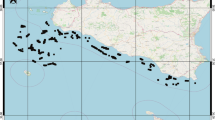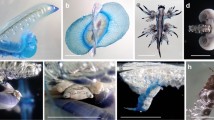Abstract
The vertical distribution and migration (seasonal, diel and ontogenetic) of Calanus helgolandicus are described from the shallow (100 m) shelf-seas to the south-west of the British Isles. In 1978 and 1979, the overwintering population of C. helgolandicus consisted primarily of Stage V copepodites and adults. By late winter/early spring the copepodites had moulted to adult females (>90%), which matured and bred the first cohorts of the year, prior to onset of the spring phytoplankton bloom in April/May. C. helgolandicus reached a peak of numerical abundance in August of 20x103 copepodites m-2 (over the depth range sampled -0 to 70 m), which was 200 times the population in winter. The seasonal peak of abundance occurred 4 mo after the peak of the bloom of phytoplankton in spring. The yearly development of the copepod was not always out of phase with the diatom bloom, as seen when the data from 1978 was placed in the context of a longer time-series collected at 10 m over 22 yr (1960–1981, inclusive). Large vertical migrations were observed in the younger copepodites (CI and II) in May from below to above the thermocline. In the remainder of the year, the CI and CII stages behaved differently and were located above the thermocline within the euphotic zone. The largest vertical displacements of biomass were seen in the summer months due to the migrations of the CV stages and adults, which had developed from the spring cohorts. It was contended that the seasonal and vertical migrations of C. helgolandicus are part of a more complex pattern of inherent behavior than has been reported previously and that, however difficult this is to discern in the natural populations, it always expresses itself.
Similar content being viewed by others
Literature cited
Bottrell, H. H. and D. B. Robins: Seasonal variations in length, dry weight, carbon and nitrogen of Calanus helgolandicus from the Celtic Sea. Mar. Ecol. Prog. Ser. 14, 259–268 (1984)
Colebrook, J. M.: Continuous plankton records: seasonal variations in the distribution and abundance of plankton in the North Atlantic Ocean and the North Sea. J. Plankton Res. 4, 435–462 (1982)
Glover, R. S.: The continuous plankton recorder survey of the North Atlantic. Symp. zool. Soc. Lond. 19, 189–210 (1967)
Klein Breteler, W. C. M., H. G. Fransz and S. R. Gonzalez: Growth and development of four calanoid copepod species under experimental and natural conditions. Neth. J. Sea Res. 16, 195–207 (1982)
Longhurst, A. R. and R. Williams: Improved filtration systems for multiple-serial plankton samplers and their deployment. Deep-Sea Res. 23, 1067–1073 (1976)
Pingree, R. D. and D. K. Griffiths: Tidal fronts on the shelf seas around the British Isles. J. geophys. Res. 83, 4615–4622 (1978)
Pingree, R. D., P. M. Holligan, G. T. Mardell and R. N. Head: The influence of physical stability on spring, summer and autumn phytoplankton blooms in the Celtic Sea. J. mar. biol. Ass. U.K. 56, 845–873 (1976)
Sager, G. und R. Sammler: Atlas der Gezeitenströme für die Nordsee und den Kanal und die Irische See, 58 pp. Rostock: Seehydrographischer Dienst der DDR 1968
Simpson, J. H.: A boundary front in the summer regime of the Celtic Sea. Estuar. cstl mar. Sci. 4, 71–81 (1976)
Simpson, J. H., C. M. Allen and N. C. G. Morris: Fronts on the Continental Shelf. J. geophys. Res. 83, 4607–4614 (1978)
Strickland, J. D. H. and T. R. Parsons: A practical handbook of seawater analysis., 2nd ed. Bull. Fish. Res. Bd Can. 167, 1–310 (1972)
Vidal, J.: Physioecology of zooplankton. 1. Effects of phytoplankton concentration, temperature, and body size on the growth rate of Calanus pacificus and Pseudocalanus sp. Mar. Biol. 56, 111–134 (1980a)
Vidal, J.: Physioecology of zooplankton. II. Effects of phytoplankton concentration, temperature, and body size on the development and molting rates of Calanus pacificus and Pseudocalanus sp. Mar. Biol. 56, 135–146 (1980b)
Williams, R., N. R. Collins and D. V. P. Conway: The double LHPR system, a high speed micro- and macroplankton sampler. Deep-Sea Res. 30, 331–342 (1983)
Williams, R. and D. V. P. Conway: Vertical distributions of Calanus finmarchicus and C. helgolandicus (Crustacea: Copepoda). Mar. Biol. 60, 57–61 (1980)
Williams, R. and D. V. P. Conway: Population growth and vertical distribution of Calanus helgolandicus in the Celtic Sea. Neth. J. Sea. Res. 16, 185–194 (1982)
Author information
Authors and Affiliations
Additional information
Communicated by J. Mauchline, Oban
Rights and permissions
About this article
Cite this article
Williams, R., Conway, D.V.P. Vertical distribution, and seasonal and diurnal migration of Calanus helgolandicus in the Celtic Sea. Mar. Biol. 79, 63–73 (1984). https://doi.org/10.1007/BF00404986
Accepted:
Issue Date:
DOI: https://doi.org/10.1007/BF00404986




